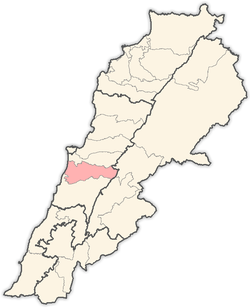Aabey
Aabey, also spelled Abey (Arabic: عبيه), is a village located in Mount Lebanon, in Aley District of Mount Lebanon Governorate. It is located 22 km (14 mi) from Beirut and has an altitude of 800 m (2,600 feet). It is bordered by Kfarmatta (South), Al Bennay (East), Damour (West), and Ain Ksour (North). It overlooks Damour and the capital Beirut and the sea can be seen from virtually any point in the village. Aabey contains the Dawdye college, Aabey Vocational School (Mihanye) etc.
Aabey عبيه Abey | |
|---|---|
 Aabey Location in Lebanon | |
| Coordinates: 33°44′13.18″N 35°31′32.70″E | |
| Country | |
| Governorate | Mount Lebanon Governorate |
| District | Aley District |
| Elevation | 2,600 ft (800 m) |
| Population | |
| • Total | 4,000 |
| Time zone | UTC+2 (EET) |
| • Summer (DST) | +3 |
The name Abey comes from the Aramaic word meaning “abundant.” The village has a remarkable history. It was during the Fatimid then the Mamlouk periods that the Tanoukh tribes came from north Arabia in the eighth century and settled in Abey due to its strategic position, in order to protect the coast against the Byzantine invasions.
Abey is a very old village famed in the past as a Druze religious center. Abey is full of remains associated with the Tannoukh Emirs, descendants of an Arab tribe settled in this region by the Abbasids around the mid-8th century.
The Tanoukh princes were very powerful and spread their control over Abey and the surrounding area of the mountain. At the end of the 11th century they fought fiercely against the Crusaders in Beirut, which had fallen into the hands of the invading Europeans. The Tanoukhs then were able to govern the coast and Beirut, which became Lebanon’s capital. The Amir Mounther Mosque is a testimony of their glory in Beirut.
The rivalry among the princes in the mountain put an end to the Tanoukhs, who were followed by the Maans. Later on the Chehab princes took over, before Abey became the administrative seat for the Ottoman ruler.
Among the monuments left by this feudal dynasty are the fountain of the Emirs, the residence of Emir Qa'an At-Tannoukhi (17th-18th centuries), the residence of Sheikh Riad Amine Eddine and the restored Druze tomb (Maqam (shrine)) of Sayid Abdallah at-Tannukhi (ca. 1479), which is an important Druze pilgrimage site.
Other monuments are the churches of as-Saydeh, Mar Sarkis and Bakhos, Mar Maroun, and the Evangelical church founded by European missionaries in the 17th century.
The Tanoukh princes encouraged advances in history, astronomy, language, medicine and poetry. Art and crafts, wood and stone carving, as well as calligraphy, flourished during the second part of the 15th century. Abey had become a cultural hub. In the beginning of the 19th century, Protestant American missionaries came to Abey and in 1839 started a medical center where the first operation was performed according to Western standards. A great number of famous personalities such as scholars, doctors, educators and journalists came from Abey, not to mention the Greek Orthodox Archbishop Gregoire Haddad.
Abey is the seat of the Nakadi druze family, the noble ruling family in Mount Lebanon along with Junblatt, Al Imad, Talhouk and Abdul Malak. Ιn 1845 part of the Nakadi family, namely sheikh Qassim beik Al Nakadi and his brothers sheikh Salim beik Al Nakadi and sheikh Said beik Al Nakadi moved to Abey from Deir Al Qamar.
Abey is the birthplace of the diplomatic de:Fouad Bey Hamza (Arabic: فؤاد بك حمزة) Saudi Arabia's Minister of Economic Development (1947-1952) in the reign of King Abdul Aziz Al Sa'ud. One of his famous books, "Al-Bilad Al-Arabia Al-Saudia".
Toufic Amin Hamza, Ambassador of Saudi Arabia in Paris and Ankara (1908–1933)
Presbyterian missionary Layyah Barakat was born in Aabey, and returned in 1922 to open an orphanage for girls there.[1]
Families of Aabey
The main families in Aabey are: Hamza, Halabi, Haddad, Hassan, Abdel Wili, Amaneldine, Ataya, Faraj, Jamal, Jaber, Nakadi, Nasr, Kuntar, Ghrayeb, Khoury, Kanaan, Raydan, Shreety, Timani and Wehbe.
References
- "To Aid Syrian Tots" Evening Public Ledger (July 3, 1922): 11. via Newspapers.com

